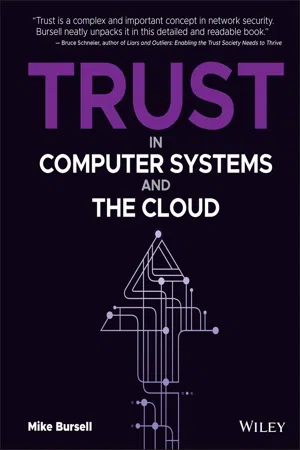
- English
- ePUB (mobile friendly)
- Available on iOS & Android
Trust in Computer Systems and the Cloud
About this book
Learn to analyze and measure risk by exploring the nature of trust and its application to cybersecurity Trust in Computer Systemsand the Cloud delivers an insightful and practical new take on what it means to trust in the context of computer and network security and the impact on the emerging field of Confidential Computing. Author MikeBursell'sexperience, ranging from Chief Security Architect at Red Hat to CEO at a Confidential Computing start-up grounds the reader in fundamental concepts of trust and related ideas before discussing the more sophisticated applications of these concepts to various areas in computing.
The bookdemonstratesin the importance of understanding and quantifying risk and draws on the social and computer sciences to explain hardware and software security, complex systems, and open source communities. It takes a detailed look at the impact of Confidential Computing on security, trust and risk and also describes the emerging concept of trust domains, which provide an alternative to standard layered security.
- Foundational definitions of trust from sociology and other social sciences, how they evolved, and what modern concepts of trust mean to computer professionals
- A comprehensive examination of the importance of systems, from open-source communities to HSMs, TPMs, and Confidential Computing with TEEs.
- A thorough exploration of trust domains, includingexplorationsof communities of practice, the centralization of control and policies, and monitoring
Perfect for security architects at the CISSP level or higher, Trust in Computer Systemsand the Cloud is also an indispensable addition to the libraries of system architects, security system engineers, and master's students in software architecture and security.
Frequently asked questions
- Essential is ideal for learners and professionals who enjoy exploring a wide range of subjects. Access the Essential Library with 800,000+ trusted titles and best-sellers across business, personal growth, and the humanities. Includes unlimited reading time and Standard Read Aloud voice.
- Complete: Perfect for advanced learners and researchers needing full, unrestricted access. Unlock 1.4M+ books across hundreds of subjects, including academic and specialized titles. The Complete Plan also includes advanced features like Premium Read Aloud and Research Assistant.
Please note we cannot support devices running on iOS 13 and Android 7 or earlier. Learn more about using the app.
Information
CHAPTER 1
Why Trust?
- My relationship to the other person
- Their relationship to me
- The different contexts of their expertise
- The impact that time can have on trust
- I trust my brother and my sister.
- I trust my bank.
- My bank trusts its IT systems.
- My bank's IT systems trust each other.
Analysing Our Trust Statements
- Case 1: My Trusting My Brother and Sister As we have already discussed, this statement is about trust between individual humans—specifically, my trust relationship to my brother, and my trust relationship to my sister. There are two humans involved in each case (both me and whichever sibling we are considering), with all of the complexity that this entails. But we share a set of assumptions about how we react, and we each have tens of thousands of years of genetics plus societal and community expectations to work out how these relationships should work.
- Case 2: My Trusting My Bank Our second statement is about trust between an individual and an organisation: specifically, my trust relationship to a legal entity with particular services and structure. The basis of the expression of this relationship has changed over the years in many places: the relationship I would have had in the UK with my bank 50 years ago, say, would often have been modelled mainly on the relationship I had with one or more individuals employed by the bank, typically a manager or deputy manager of a particular branch. My trust relationship to the bank now is more likely to be swayed by my views on its perceived security practices and its exercising of fiscal and ethical responsibilities than my views of the manager of my local branch—if I have even met them. There is, however, still a human element associated with my relationship, at least in my experience: I know that I can walk into a branch, or make a call on the phone, and speak to a human.3
- Case 3: The Bank Trusting Its IT Systems Our third statement is about an organisation trusting its IT systems. When we follow our new resolution to rephrase this as “The bank having a trust relationship to its IT systems”, it suddenly feels like we have mo...
Table of contents
- Cover
- Table of Contents
- Praise for Trust in Computer Systems and the Cloud
- Trust in Computer Systems and the Cloud
- Introduction
- CHAPTER 1: Why Trust?
- CHAPTER 2: Humans and Trust
- CHAPTER 3: Trust Operations and Alternatives
- CHAPTER 4: Defining Trust in Computing
- CHAPTER 5: The Importance of Systems
- CHAPTER 6: Blockchain and Trust
- CHAPTER 7: The Importance of Time
- CHAPTER 8: Systems and Trust
- CHAPTER 9: Open Source and Trust
- CHAPTER 10: Trust, the Cloud, and the Edge
- CHAPTER 11: Hardware, Trust, and Confidential Computing
- CHAPTER 12: Trust Domains
- CHAPTER 13: A World of Explicit Trust
- References
- Index
- Copyright
- Dedication
- About the Author
- About the Technical Editor
- Acknowledgements
- End User License Agreement